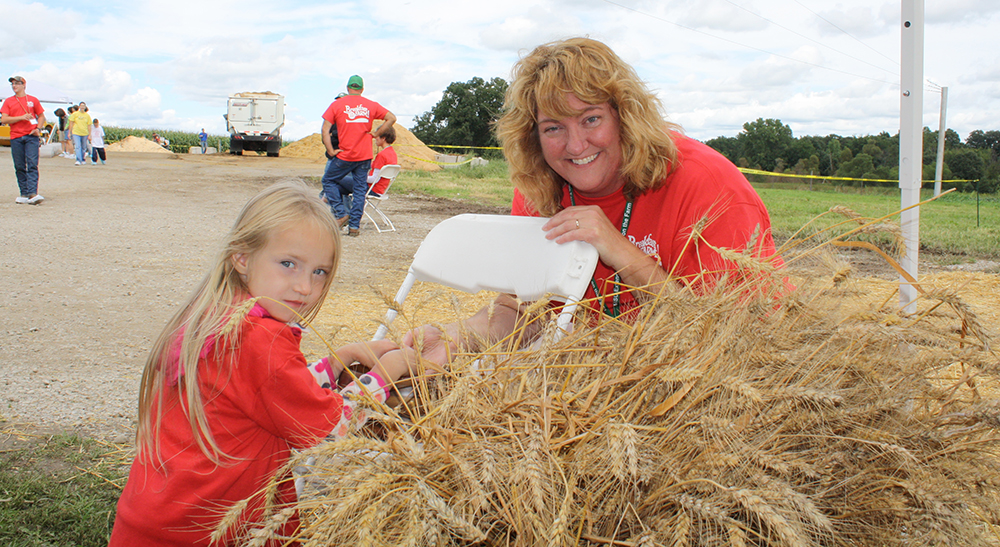Menu

Consumers are a very important part of wheat world! Consumers make decisions every day with their grocery dollar as to what foods they want to include in their diet. There is much information and also some confusing information about wheat. Please use this page as a resource about what happens on the farm, the facts about gluten, recipes of food to try on your own and resources to use to educate the next generation.
Please join us in this video below to experience wheat harvest first hand with Mike Milligan from Cass City (up in the thumb) of Michigan. The thumb area of Michigan is home to four of the top five wheat producing counties in the state. Wheat is grown in 50 of the state’s 83 counties. It is planted in the fall and over winters, much like your lawn, until spring when it starts actively growing again. Wheat is a very sustainable crop, as it is in the ground for about 10 months keeping soil in place.
This ride-along video tells how technology is used in the planting of wheat, and what farmers must consider when planting. Interviewer is Elaine Bristol of the Michigan Ag Council.
Sustainable. Wheat is the world’s second-most widely grown grain. Michigan’s soft red and white wheat varieties are planted each fall and harvested the next summer. That makes wheat particularly helpful in reducing erosion because the growing plant provides ground cover during the high-rain periods in fall and early spring.
Wheat also enriches soil by capturing nitrogen and adding organic matter. In fact, some studies show that by growing wheat, farmers can increase yields of other crops planted in the same fields.
Ride along with Michigan wheat farmer Mike Milligan and lively Michigan Ag Council reporter Elaine Bristol in this 5-minute video to see wheat being harvested and learn how it ends up on your kitchen table.
Nearly 8,000 wheat farmers plant about 450,000 acres of wheat each year. One acre is about the size of one and a third football fields. At harvest our farmers have about 40 million bushels of wheat. The wheat grown in Michigan is mainly for cereals, crackers, cookies, pastries, cakes, and thickeners in foods like soup and licorice. If you took all of our wheat you could make 50 billion cookies!!
Feel free to download, copy and distribute these items below at your local event. If you have other wheat educational item needs, please contact the office via email and let us know how many participants, what age range and what activity/event you’re organizing. We will do our best to accommodate your request.
Nutritious. Wheat grains, enriched and whole, are great sources of folic acid, fiber, iron, magnesium, vitamins E and B, antioxidants, thiamin, riboflavin and more! Complex carbs found in wheat supply people with energy and are low in fat, cholesterol and sodium.
US Dietary Guidelines recommend eating six 1-ounce portions of whole grains daily.
Diverse. Wheat is not only used in many different foods, but it is also milled into many different flours. Download this handout from Michigan State University Extension.
In January 2015, Consumer Reports (CR) shed light on the gluten-free diet fad. CR wrote that most people probably don’t know that a gluten-free diet can actually cause weight gain! Or that it costs more and can increase one’s exposure to arsenic.
This science-based article talks about many unanticipated – and unwelcome – effects of following a gluten-free diet when a person does not have celiac disease. Read more at consumerreports.org/cro/magazine/2015/01/will-a-gluten-free-diet-really-make-you-healthier.
Have you heard about the exciting new ways to use wheat?
Wheat berries, freekeh and farro are some of the “new” healthy wheat ingredients! Watch this to learn more about wheat berries.
. . . . . . . .
Please click here for some of the best Michigan wheat recipes.
The Michigan Wheat Program is a state-check off program voted in by the state’s wheat farmers to assess each bushel of wheat grown and sold. The funds from the program are utilized to further the wheat industry in the state benefitting the state’s nearly 8,000 wheat farmers who grow about 450,000 acres of wheat annually producing about a 40 million bushel crop.